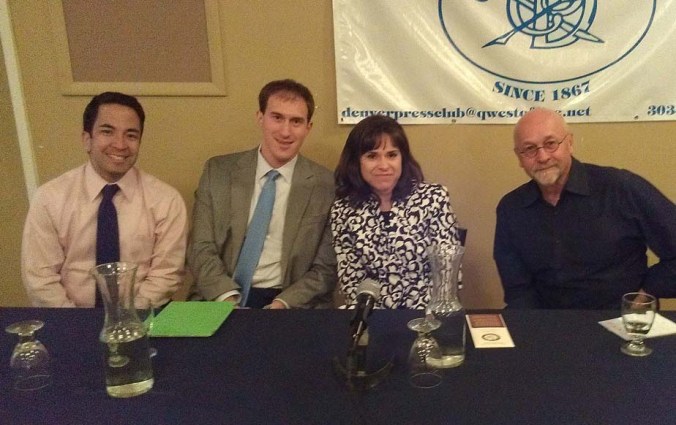
Left to right: Tak Landrock, Phil Tenser, Vikki Migoya and Rob Reuteman, at SPJ Colorado Pro’s panel discussing social media and breaking news.
By Ed Otte
Old-fashioned reporting practices are as important as the newest software in digital journalism.
That message was emphasized in a June 18 panel discussion on social media and breaking news at the Denver Press Club. The program, sponsored by the Colorado Pro Chapter of the Society of Professional Journalists, featured reporters and editors from Fox 31, 7News and The Denver Post. Rob Reuteman, business journalism professor at Colorado State University, was the panel moderator.
“Social media is an incredibly valuable reporting tool. We’ve found that that’s how people want to get their news,” Reuteman said. “But what are the challenges with that?”
The answer: Temptation to post or tweet a story first, even in a very competitive news market such as Denver, is tempered with the need for accuracy.
“The push that social media has forces us to be first with a story. We need to get the hits on a story, that’s good for busienss, ” said Vikki Migoya, Denver Post suburban and community news editor. “But, in a way, social media hasn’t changed what we do. Even though the media changed the way we report the news, we still have to check the facts.
“The work is the same. Only the tools have changed.”
Another factor that hasn’t changed, according to 7News digital executive producer Phil Tenser, is the news organization’s credibility.
“It isn’t the pressure to be first,” he said. “You want the second tweet or Facebook post to be complete and accurate. Verfication is a very big deal. When someone sends something to you on Facebook or Twitter, has that photo been filtered? Is the statement accurate? If your team is passionate about their jobs, they’ll take the time to verify stories.
“I don’t want to throw anyone at our station under the bus but, a good example of this, a photo of a tornado was sent to us last week. It implied it was taken at that time in eastern Colorado. Our weather person put it on his Twitter account. We checked it and found out the photo was two years old. You need to check the veracity of everything. You need to have a workflow procedure that ensures accuracy.”
Fox31 reporter Tak Landrock said, “Some younger journalists don’t check their facts. They simply retweet what they see. That doesn’t help us. If someone tweets to your newsroom that John Elway was hit by a car, you need to verify it. You can’t just post it.”
“I’d rather be last and correct than first and wrong.”
“Facebook pages,” Migoya said, “are good reporters’ tools. It’s just like knocking on doors and asking questions. But the policy at The Denver Post is we take the time to verify statements and photos. The same with Twitter. We use it to go back and get the official word.”
Reuteman asked if questionable content on reporters’ personal Facebook pages and Twitter accounts can jeopardize their employment.
“The Denver Post has a policy that we feel very strongly people represent The Denver Post at all times,” Migoya said. “We had to let a person go recently because of what he said on social media. Employees must adhere to the policy.”
“Viewers see us every night on TV,” Landrock said. “I have to be very careful about what is on my Facebook page. I can’t be tagged with a photo of me holding a glass of beer and looking wasted.”
On the business side of digital journalism, Tenser said, “I spend a lot of time training our staff on new social media tools but the thing we still struggle with is how to make money with social media. When you talk about something of grand importance, you need to be more creative. You need more than dancing hampsters.”
To bolster online ad revenue, he said 7News is looking at native advertising, similar to traditional advertorials minus the overwhelming tie-in to the sponsor’s brand.
“Our digital team can support itself with the revenue it generates. But we can’t support the other parts of the operation – newsprint, the presses, the delivery of the paper,” Migoya said. “The advertising comparison is still digital dimes to print dollars.”
You must be logged in to post a comment.